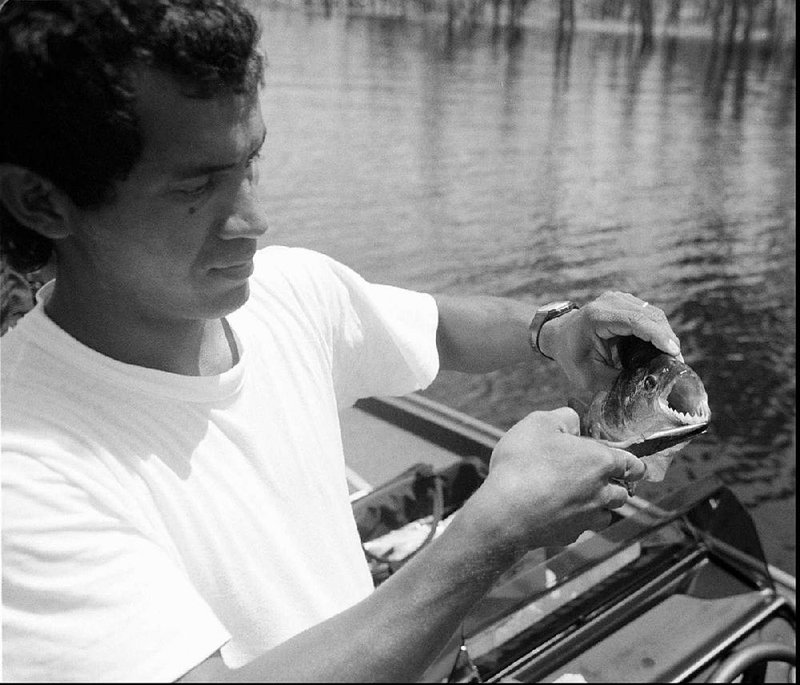Dear Otus,
I notice that a piranha was caught in Lake Bentonville on May 1. Now we're all scared to go there to watch the planes land despite reassurances from the Arkansas Game and Fish Commission.
I'm a longtime reader. Didn't you warn us about piranhas some years back? I'd love for you to rerun that column.
-- Lex Talionis
Rogers
Dear Lex,
It was wholly a pleasure to hear from you and to note that the AGFC said Monday that piranhas have been caught in Arkansas before but "they cannot survive our low winter water temperatures, so no populations have ever been established."
Well, just tell that to the folks around Lake Jack Lee. Here's my clarion call to action as first reported on Feb. 3, 1996.
Bottom line: We've heard this disingenuous, duplicitous "too cold" blather before.
The recent reports of piranha in Felsenthal National Wildlife Refuge have game and fish authorities concerned, but also urging the public not to panic. Unfortunately, that's little comfort to the sportsmen and other outdoors enthusiasts who frequent the area at the juxtaposition of Bradley, Union and Ashley counties.
"We aren't completely certain that what we have here is piranha," Brian Agnatha, Arkansas state ichthyologist, said last week. "In fact, the alleged attacks may well have been by alligator gar or any of several ganoid fishes of the genus Lepisosteus. At any rate, we're certain the instances are isolated and will most likely not occur again."
The attacks to which Agnatha referred took place Jan. 20 on Lake Jack Lee and were witnessed by several hunters from nearby Crossett.
Horace Dupree told the El Dorado News Times, "When we saw all that blood boiling up we knew it was something more than a wounded deer. In a matter of minutes there was nothing left but a bag of bones and a 12-point trophy rack."
Law enforcement officials in neighboring Louisiana have reported two similar instances in recent weeks. Morehouse Parrish sheriff's deputies say an anonymous tipster claimed he lost a 70-pound coon dog in bottomland along the Ouachita River only four miles below Felsenthal Lock and Dam.
When pressed, Agnatha would not rule out the possibility that piranha had found their way to southern Arkansas.
"Sure, I guess anything's possible," Agnatha admitted, "but even if these 'attacks' were by piranha, I doubt the fish would survive the entire winter in Lake Jack Lee. If they were [piranha] they were more than likely put in the lake by pranksters and, like the alligators in the sewers thing, these rumors soon take on a life of their own."
A local official who asked to remain anonymous said, "We'll have signs posted at Moro Bay State Park. That's where we're really expecting our first trouble come spring. The Saline [River] is much too swift to accommodate piranha, but the Ouachita River up to about Sparkman is ideal."
Moro Bay, in southwestern Bradley County, is about 12 miles up the Ouachita from where the hunters witnessed the deer evisceration. The official voiced concern that swimmers, lured into a false sense of security by AGFC, could be attacked and overwhelmed without warning.
"I wouldn't be able to look myself in the mirror if some little girl or boy got turned into fish food and we hadn't warned people to watch out," he said.
Assistant curator Wolfgang Fischgesicht, an expert in the carnivorous fish's behavior patterns, was contacted at the Audubon Aquarium of the Americas in New Orleans and offered these observations.
"Piranha typically hunt alone," Fischgesicht stated, "but in times when food is scarce, the piranha become ravenous and congregate in packs. They will send out a scout fish to select a victim. The scout will take a small bite and the blood will attract the pack, which can range from 20 up to 800 fish. They have been known to strip a fully grown cow to nothing but bone in eight minutes."
Fischgesicht noted that there were 25 species of piranha, but only three have been known to attack man.
"If you've got the red-bellied piranha up there -- the Serrasalmus nattereri -- then you've got quite the little monster on your hands," Fischgesicht said. "They get up to a foot long and have teeth like a mouth full of razor blades."
Fischgesicht said that if you are attacked, you should swim as slowly and quietly as possible to the bank and simply walk out.
"Thrashing and screaming just gets them all riled up," he said.
Until next time Kalaka reminds you to use the buddy system. Just swim faster than your buddy.
Disclaimer
Fayetteville-born Otus the Head Cat's award-winning column of
Z humorous fabrication X
appears every Saturday. Email:
HomeStyle on 05/09/2015

